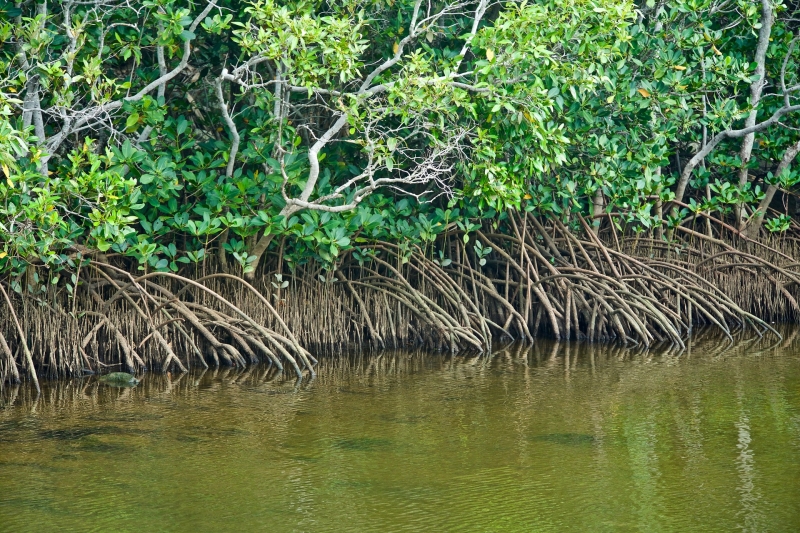From land, the small, shrub-like mangrove trees that line tropical coastlines appear rather ordinary—a closer look, however, tells a completely different story. Hidden underwater, mangrove trees have spindly roots overflowing with marine biodiversity. These roots allow mangroves to survive in brackish coastal waters, an environment most trees could never tolerate. Just like their peculiar beauty, mangroves’ importance in the global carbon cycle is also widely overlooked. Mangroves are critical blue carbon sequesters, storing thousands of tons of carbon dioxide in their oxygen-poor soil.
 Blue carbon refers to carbon dioxide removed from the atmosphere by coastal ocean ecosystems, including salt marshes, seagrasses, macroalgae, and mangrove forests. These ecosystems sequester large quantities of carbon through plant growth and accumulation and burial of organic matter in sediment. Blue carbon accounts for half of all carbon sequestered in ocean sediments. Mangroves are especially critical for blue carbon and perform several important jobs along coastlines. As a carbon sink, mangroves store up to 6.5 billion tons of carbon. Mangroves enhance carbon sequestration four times more than inland tropical rainforests. By buffering coastlines, mangroves save more than 80 billion dollars per year in avoided losses from coastal flooding and hurricanes worldwide. They serve as natural hazard mitigation structures, reducing damage caused by disasters like storm surges, erosion, floods, and rising sea levels. Finally, mangroves are home to a large variety of fish, crabs, mollusk, shrimp, and other essential food sources for coastal communities, especially in Small Island Developing States (SIDS).
Blue carbon refers to carbon dioxide removed from the atmosphere by coastal ocean ecosystems, including salt marshes, seagrasses, macroalgae, and mangrove forests. These ecosystems sequester large quantities of carbon through plant growth and accumulation and burial of organic matter in sediment. Blue carbon accounts for half of all carbon sequestered in ocean sediments. Mangroves are especially critical for blue carbon and perform several important jobs along coastlines. As a carbon sink, mangroves store up to 6.5 billion tons of carbon. Mangroves enhance carbon sequestration four times more than inland tropical rainforests. By buffering coastlines, mangroves save more than 80 billion dollars per year in avoided losses from coastal flooding and hurricanes worldwide. They serve as natural hazard mitigation structures, reducing damage caused by disasters like storm surges, erosion, floods, and rising sea levels. Finally, mangroves are home to a large variety of fish, crabs, mollusk, shrimp, and other essential food sources for coastal communities, especially in Small Island Developing States (SIDS).
Despite the benefits mangrove ecosystems offer to both humans and the environment, mangroves are being cleared at a rate of 2% per year and account for up to 10% of global emissions from deforestation, despite only covering 0.7% of land. When mangrove forests are degraded or destroyed, they release the carbon stored in their soil and can no longer serve as carbon sequesters. Scientists estimate that 1.02 billion tons of carbon dioxide are released annually from degraded coastal ecosystems.
Southeast Asia contains the largest amount of mangroves in the world, yet these ecosystems are continuously being destroyed and used for commercial purposes. Indonesia, for example, contains about 20% of the planet’s mangrove forests, yet has lost 40% of its mangrove ecosystems in the past three decades. The largest driver of mangrove degradation is aquaculture, as mangroves provide nutrient-rich, sheltered water and large populations of juvenile shrimp. The next biggest driver of mangrove degradation is urban coastal and agricultural development, such as palm oil and rice plantations. Indonesia is at risk of losing all its mangrove forests in coming years due to human activities and sea-level rise. The Indonesian government needs to enforce strong policies, market-based measures, and community self-management in order to save the country’s surviving mangroves. Sri Lanka offers a prime example.
In 2015, the Berkeley-based organization Seacology and the Sri Lankan NGO Sudeesa helped launch the Sri Lanka Mangrove Conservation Project, making Sri Lanka the first country to formally protect all 22,000 acres of its mangrove forests. Through this program, the government provides alternative job training and microloans to 12,000 Sri Lankan women who live in small communities near mangrove forests. In exchange for training and loans, each woman is responsible for planting and growing about 21 acres of mangrove forest (for a total of 9,600 acres being replanted). The country also built the first museum to educate the public on the importance of mangrove ecosystems. In addition to this project, Sri Lanka passed the National Policy on Conservation and Sustainable Utilization of Mangrove Ecosystems in Sri Lanka, which outlines specific policies and laws to protect mangroves. Pairing policy and action allowed for greater success in implementing new conservation programs and efforts.
Indonesia’s Minister of the Environment recognizes that the country’s mangroves are in danger. And in 2018, ELI, in partnership with the Indonesian Center for Environmental Law (ICEL), conducted a judicial capacity-building project in Indonesia to help judges become strong players in the fight against deforestation. But sadly, the government of Indonesia refuses to enforce current environmental protection policies or create new ones. Mangrove forests provide future generations with an important carbon sink and opportunities for employment. Rather than relying on environmental destruction to create jobs, Indonesia should adopt Sri Lanka’s practice of creating jobs for communities to restore the environment, both for themselves and for the generations to come.
Worldwide, mangrove forests will be lost by 2050 if increasing rates of carbon emissions, sea-level rise, and destruction of mangrove ecosystems continue. Despite massive losses, conservation of blue carbon sinks is gaining international momentum. NGOs and organizations are launching projects and initiatives to save mangroves and other types of coastal ecosystems. With effective and aggressive policies and field projects, blue carbon sequesters can be restored and continue to play an important role in mitigating climate change.
